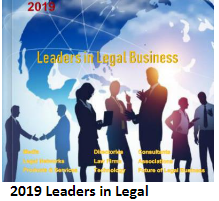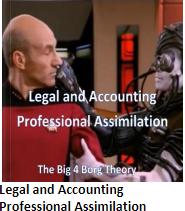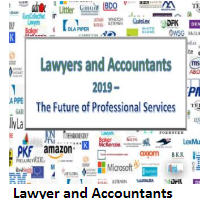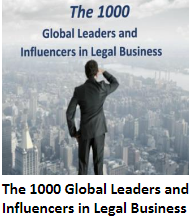A
consolidated profession is the opposite: a small group of companies or
organizations dominating the profession. The remainder of the business market
remains fragmented.
The
first problem of a fragmented profession is inefficiencies. Virtually all
products and services are sold to customers and clients are “retail” … one by
one. This is the most expensive way. This includes not only legal
services of lawyers themselves but virtually all associated products and
services. Retail sales is the natural extension of the fragmented market.
The
second problem is that fragmented professions make ideal targets for firms
looking to enter and potentially dominate and disrupt the market. Markets
can be readily assimilated. This is similar to the Borg in Star Trek seeking to
assimilate every alien being … their mantra is “resistance is futile”. The
nature of fragmented professions means that they often provide
fewer barriers to the disruptors. This makes fragmented businesses or
professions highly appealing for strategic disruptors.
Warren
Buffett said: “In business, I look for economic castles protected by
unbreachable ‘moats.’”[3] An
investor will be looking for a profession with a highly defensible market
position. “The issue is that the many competing businesses and firms have spent
their time and resources on fighting each other rather than maintaining a moat
to protect themselves from disruption.”[4] This
allows the new consolidating competitors to build bridges across the moat. The
fighting continues while the castle is being breached. The new competitor can
sell wholesale to a larger market and at a greater profit.
As Michael
Porter states in Competitive Strategy: Techniques for Analyzing Industries
and Competitors [5]: “Overcoming fragmentation can be a very significant strategic
opportunity. The payoff to consolidating a fragmented industry can be high
because the costs of entry into it are by definition low, and there tend to be
small and relatively weak competitors who offer little threat of retaliation.”[6]
The cost to
the fragmented market providers can be very high because the fragmented system
is suddenly replaced. Adaption to the new market require tremendous efforts.
Understanding
Market Fragmentation
Fragmented
markets consist of small, medium, and even relatively large organizations that
compete with one another. No single organization or group of organizations
dominates the entire global market.
In
a fragmented market establishing and maintaining a brand is key. A brand reputation must
reverberate throughout the marketplace. It must distinguish the firm or company
from its competitors. This can be difficult in one state or country, and is
multiplied in a global market.
On
the other hand, in law, implementing a fragmented industry strategy means firms
do not need to concern themselves about fighting for market share against major
firms who may be in another distinct segment. They can develop their practices
in a number of segments at a relatively low cost at a relatively high rate of
return. This ensures that they are taking advantage of the fragmented
profession as it relates to new opportunities.
Examples of a
fragmented market include clothing retailers, businesses selling furniture,
agriculture, and landscaping, book publishing, bulk building supplies, and
others. [7] In a fragmented market, product and service
segmentation can be intense, responding differently to marketing. These
multiple segments are also indicative of a fragmented market.
This is not
to say that in a fragmented market, product and service segmentation can be
intense, responding differently to marketing. These multiple segments are also
indicative of a fragmented market.
A market
becomes fragmented for many reasons. Some are: 1.The needs of clients; 2.
Generally a low level of innovation in products and services; 3. No economies
of scale; 4. Strong competition in the market; and 5. Customization of the
product is high within the segments.[8]
Advantages of a Fragmented market
Fragmentation
works well in specific businesses. A fragmented market can help businesses
reach the right consumers and clients. Based on demographics, behaviors, and
interests of the consumer, a fragmented market makes it easier for businesses
to target their products to
specific consumers and clients.
Since
there is no dominant player in a fragmented market, it implies that clients
have not given their loyalty to any business and that few standards exist in
that market. This also implies that new entrants in the market have latitude
for investigation and innovation of new products and services.[9]
Fragmented
markets may lead to a smaller client base, which makes it easier for businesses
to pinpoint the interest of their clients more effectively. Marketing expenses
of businesses may be reduced in a fragmented market. In many cases, the
marketing is focused on local or regional clients. The advertising expenses are
less than nationwide or global coverage.[10]
A
fragmented market favors firms with a smaller footprint. For example, with
entry of the Big 4 into the legal profession, the largest law firms will incur
incremental expenses to compete while the Big 4’s are scalable being spread
across more markets. Thus, it is cost-effective for firms trying to enter a
fragmented market not to start new practices. A fragmented market also gives
firms an opportunity to target clients
that other firms in the legal profession may have missed.
Disadvantages of a Fragmented market
One firm’s
advantage is another’s disadvantage. Like any other market, a fragmented market
has its own set of challenges. As markets fragment, businesses need to be aware
of the multiple platforms that can be used to reach their target clients and
then use these to market themselves. As such, it becomes important for firms to
track every change in the marketplace since their competitor are doing the
same.
In
a fragmented market, firms also need to ensure that their marketing strategies
are consistent and adapted to the qualities of a different marketing methods.
In a fragmented market, the need for continuous repetition of branding messages
is a common issue.
Segmentation
Segmenting
follows both fragmentation and consolidation. At its most fundamental level, it
is the separation of a group of clients with different needs into subgroups
with similar needs and preferences. By doing this, a firm can better tailor and
target its services to meet each segment’s needs.[11]
Characteristics
of segmentation are: [12]
· Firms rarely create a
segment — more often they uncover one.
· Segmentation and demographics
are very different things. Demographics such as age, sex, religion, etc. are
not segments. Segments are the interests of individuals or businesses cutting
across demographics.
· Segmentation decisions are
made based on information.
Regardless
of the approach, a useful segmentation strategy would include these six
characteristics: 1) Identify each segment and measure their
characteristics, like demographics or usage behavior; 2) Must be large enough
to be potentially profitable; 3) Should be able to reach its segments via
communication and distribution channels; 4) Should be stable enough for a long
enough period of time to be marketed strategically; 5) A segment should have
similar needs that are clearly different from the needs of others in other
segments; and 6) Actionable to be able to provide products or services to each
of these segments.[13].
Law
and Accounting – Fragmentation and Consolidation
Law
Institutional
fragmentation has served the legal profession well for 50 years. In modern
times, the possibility to consolidate appeared unlikely because each state
or country has its own bar regulations and each law school its own curriculum,
their own courts, procedures, etc. A significant professional ethical
moat was created.
Clients
did not require a consolidated profession in the non-global marketplace. In
each segment of law there were firms that could meet the legal services needs
of clients from the smallest to the largest. However, even the largest had
extremely limited coverage. Their offices are predominately in 15 popular
locations, such as New York, London, Paris, Brussels, Chicago, Hong Kong,
Tokyo, and Frankfurt. Networks and ad hoc personal connections filled the gap
in market coverage.
The
legal media has also effectively protected the legal services business with
terminology describing the largest firms as members as the AmLaw 100, White
Glove or Magic Circle firms. The media’s focus remained primarily on the
largest law firms because they were the best known. This provided significant
low-cost brand awareness and marketing.
The
legal profession was also lucky that Enron occurred and Sarbanes Oxley held off
the Big 4’s strategy of consolidation. Regulations in the United States may,
however, be changing in several states to open legal practice to partnerships
with non-lawyers.[14]
What
has changed? Today, size has become even more important. When one compares the
revenues of the 100 largest law firms with the Big 4, they equal the combined
revenues of just two: Deloitte and PwC. The 100 largest firms are in, on
average, 15 countries compared to the 160 of the Big 4. This creates the
opportunity to scale services in each market based upon clients’ needs.
Alternative Legal
Services Providers (ALSPs) – Erosion of Legal Services
ALSPs
represent the point of connection between law and law-related services. The
market for these services is fragmented. None of these organizations is
restricted by legal ethics in that they do not practice law. Without similar
restrictions, they can be more innovative in their approach to legal business. [15]
At
present, there is no dominant organization. This is changing. Elevate Services
is consolidating a number of these services with acquisitions. The Big 4 are
developing these services to be offered worldwide to firms and corporations.
They are also acquiring larger alternative providers.[16]
While
a number of large law firms [17] are
investing in their own versions of ALSPs, general fragmentation of the market
makes this difficult since marketing them is not within their core
competencies. There are many startups in this sector. Segmentation is also made
more difficult when the largest business organizations like the Big 4 and the
four largest companies (Lexis Nexis, Bloomberg, Thomson Reuters, and Wolters
Kluwer) occupy adjacent spaces.
The
Internet: Redefining Fragmentation and Segmentation
The
Internet introduces two new consolidation factors. [18] Unlimited
information is now available on products and services. Existing brands
themselves can be consolidated by creation of new delivery modes. This is a
different form of consolidation.
Information in a
consolidating market
The
Big 4 and the largest law firms combine useful information with modes of
delivery. Today, it is possible to separate delivery of information from legal
practices. In other words, market share can be developed without the burden of
developing a legal practice through providing information that places potential
business clients in direct contact with vetted firms and lawyers. The potential
client can then make their own evaluation of the lawyer’s expertise and
comparative cost in real time.
An
example in retail is Amazon.[19] They have adopted a model of consolidating multiple products and
services under one roof by making comparative information available on each
product. Its market share is unlimited because it concentrates on information
distribution first, and then distribution of others’ products and services. The
result is that the “retail” industry has been rocked by this change in the
information distribution structure. Stores cannot offer the same broad choices
or a cost-effective delivery system for a single product line. Why go to a
store when the same toy is available on Amazon for a lesser price and it is
delivered the next day to your home for free?
Another
similar example is Uber. It has taken a completely fragmented business,
personal transportation, and consolidated it. It was followed by Lyft.
Social Media Disruption -
Brands
The
Internet also exploits brands, which each of the Big 4 already has. A
comparison of the number of monthly users is indicative of their market power.
For example, Big 4 firms each receive 10 times the number of unique users per
month than the sites of largest law firms. [20] The Big 4 all ranked among the top 100 brands in the world. [21]
The Tale of Two Futures – Assimilation or Legal Independence?
The
merging of accounting/consulting and law could result in the entire legal
profession dominated by the Big 4. This assumes there is no alternative
consolidation model. This does not have to be the case. There is one unknown in
the market that could consolidate a greater market share than the combined Big
4 and can offer more services.
Big 4 –
Assimilation of legal services and the profession
The
best strategy to disrupt a fragmented market such as the legal profession is
“to develop a multi-sided platform model which does a better job of meeting
unmet demand or allocating resources more efficiently, either for the benefit
of incumbents, consumers, or ideally both.” [22] Opportunities in fragmented industries are found for
entrepreneurs willing to provide the right sort of platform. These are
segmentation opportunities.
The
moat surrounding the legal profession’s proverbial castle is not deep or wide
enough to stop the Big 4. Their breadth and depth of their new moat are
increasing daily. The results are as follows:
1. Global – The legal and accounting markets are global. The Big
4 have operations in 160 countries. Large law firms are predominately
based in the U.S. or England. Conversely, the footprint of the largest law
firms are, on average, fewer than 20 countries. Their comparative global
footprint to law firms is reflected in the percentage of lawyers outside of the
United States. [23]
2. Scope of services – Services are broad, including broad
spectrum of advisory services. Legal services are only one additional service
that the Big 4 offer.
3. Technology – The Big 4 are developing internally scalable
technology that can be offered to their clients and potential clients. The
technology is scalable, so it can be offered to the full range of clients.
4. Local presence – The Big 4 are already part of local business
and not perceived as foreign. They represent more business clients
outside of the dominant countries. As these clients expand, they use the Big 4.
This is a version of the network effect.[24]
5. The legal media has officially recognized them as part of the
legal profession.[25] There
are now countless articles on the Big 4 gradually extending to legal practices.
6. The Big 4’s financial resources are essentially
unlimited.
7. The Big 4 are rated among the 100 most recognized brands in
the world. No law firm is even close to this level of brand recognition. They
are now being ranked specifically within the legal market.
8. The Big 4’s structural model is a network rather than
integrated firms, which creates flexibility in their operations and continuous
opportunities to expand at lower costs.
Alternative Future –
Consolidation with GlobalLegalLeaders.com
Consolidation
of Law and Accounting through Networks and Associations to carve out $300
billion of services
In
a fragmented market, the only defensive opportunity lies with the potential
consolidation of a significant part of the B2B legal profession. This
means the consolidation of legal and accounting networks with other companies
who have something in common: offering their clients comprehensive quality
services and common competition: the Big 4.
The
combination of law and accounting networks with other providers such as AI,
Blockchain, and other technology can create something larger than the Big 4. An
Internet platform creates a more effective organization in that it can
simultaneously incorporate (assimilate) other associated by business at no significant costs to provide clients. Each firm or company
remains completely independent.
Utilizing
the same models underlying Amazon, LinkedIn, and Uber, an alternative can
easily be implemented. All that is necessary is:
1. Carving out legal and accounting firms that are members of
networks. The members of 75 networks annually provide $180 billion in services
to clients. This is 15% of a $1.1 trillion market, which effectively defrags
the markets. They have been jointly organized over the last four years.
2. Utilization of the investment of several billion dollars already
spent to develop professional and personal relationships among members of law
and accounting networks over 30+ years. (Similar to Uber where drivers use
their own cars.)
3. Exclusively providing access to the exact expertise and
experience of 600,000 vetted professionals at 10,000 firms virtually
everywhere on earth in minutes.
4. Offering the only real-time use of the system to
all professionals in the world for free. This makes all business lawyers and
accountants global.
5. Developing a continuing customer relationship as a result of
the personal dashboard management system for each user and replying firm.
(Similar to LinkedIn.)
6. Incorporating virtually any service or product related
to law and accounting for users, tagging each to the matter for secondary
product and sales. (The “one-stop shop” model of Amazon.)
7. Creating a global minable meta-database of transactions and
litigation matters deployable for product and service creation. The same
database can also be deployed for the sale of transaction and litigation
analytic products and services.
8. Assembling a built-in customer database of 10,000 legal and
accounting firms for products and services. They can be marketed through the 75
networks to their members. This creates an unlimited number of potential
clients for these new incremental services.
9. Creating a proactive vendor “market” by placing
products and services such as ALSP services in front of users based upon actual
matters – a form of AI dynamic personalization. (Similar to Amazon – “People
who purchased X also purchased Y.”)
10. Operating with minimal administrative or financial
costs. Maintenance and expansion work can be done by users, firms, and
networks. (Similar to LinkedIn.)
11. Developing scalable AI and blockchain applications that can
be incorporated and sold to network member firms, user firms, and
organizations.
12. Growing a network’s user base at no cost as
other professionals within the firms are brought into the matter or
litigation. The network’s effects are similar to Facebook and LinkedIn.
No app needs to be downloaded to participate.
13. Transforming the retail market to wholesale for
vendors of law- and accounting-related products and services by sales through
the networks to their members, reducing the overall cost of sales.
14. Generating potential horizontal and vertical revenue streams
of an estimated $30 - $50 million within the first 18 months. This requires
first establishing identifiable brand credibility with the 10,000 firms on the
site.
Conclusion
The
fragmented legal profession is now confronting organizations that have already
consolidated globally. As networks, the Big 4 has flexibility that law firms do
not have to easily add services to their client menu. They have a staff in each
country that is able to market new products and services to existing and
prospective clients. Compared even to the largest law firms, their resources
are basically unlimited. Without the intervention of another organization,
there is a real possibility that the legal market in 2025 will resemble the
accounting market of today. The Big 4 will be the dominant force. Law firms
that will remain will be defined by a fragmented market.
Certain
segments may be largely exempt from domination, such as criminal lawyers. The
firms most affected will be firms of 30 to 1,000 B2B
lawyers. Outside of the U.S. all commercial and IP firms will feel the
changes. Others will be exempted as long as the Big 4 do not see their segments
as profitable.
There
is a better alternative than the Big 4. Under GlobalLegalLeaders.com networks, firms and
others services providers are able to work for common objectives. They can make
available to clients a broader source of services at the same quality and a
lower cost … a new wholesale marketplace is created.
_____________________________________________________________
[1] Stephen J. McGarry: BA, MA, JD, LLM (Tax) Admitted: TX
LA MN Founded: Lex Mundi and WSG - the world's two
largest law firm networks (Combined 44,000 attorneys in 1,200 offices
with annual revenues of $20+ billion). Created: HG.org, one of
the first 10 legal websites in 1995 (Today receiving 1.3 million unique users
per month). Met in person with over 400 law firms in
more than 100 countries and every US state and Canadian province. Published: Numerous
publications including ALM’s Multidisciplinary Practices and Partnerships, the only treatise on the Big 4 in law. Languages: French,
German, Spanish Featured in: Wall Street Journal, American
Lawyer, IFLR, National Law Journal, Legal Business, Financial Times and other publications.
[2] The Borg is a fictional alien
race in Star Trek - The Next Generation. The
Borg are cybernetic organisms, linked in a hive mind called "the
Collective." The Borg co-opt technology and knowledge of other alien species for the Collective through the process of "assimilation": forcibly transforming individual beings into
"drones" by injecting nano-probes into their bodies and surgically augmenting them with
cybernetic components. The Borg's ultimate goal is "achieving
perfection." https://en.wikipedia.org/wiki/Borg; The Borg,
YouTube: https://www.youtube.com/watch?v=WZEJ4OJTgg8.
[3] Matt Linderman, Warren Buffett on Castles and
Moats, Basecamp (March 27, 2007), https://signalvnoise.com/posts/333-warren-buffett-on-castles-and-moats.
[4] Id. at 3.
[5]Michael Porter, Competitive Strategy: Techniques for
Analyzing Industries and Competitors, available at
https://www.amazon.com/Competitive-Strategy-Techniques-Industries-Competitors/dp/0684841487.
[6] Id.
[7] Hitesh Bhasin, What is a Fragmented Market?, Marketing
91 (August 10, 2018), https://www.marketing91.com/fragmented-market/.
[8] Id. at 7.
[9] Id.
[10] Id.
[11] Market Targeting – Target Segments Efficiently and
Effectively, Marketing Insider Europe,
https://marketing-insider.eu/marketing-explained/part-i-defining-marketing-and-the-marketing-process/market-targeting/.
[12] Gretchen Garett, What You Need to Know about
Segmentation, Marketing (July 9, 2014),
https://hbr.org/2014/07/What-you-need-to-about-segmentation.
[13] Id. at 12.
[14] Sam Skolnik & Amanda Iacone, Big Four May Gain
Legal Market Foothold With State Rule Change, Bloomberg
Law (April 11, 2019),
https://biglawbusiness.com/big-four-may-gain-legal-market-foothold-with-state-rule-change.
[15] James Goodnow, Meet the Alternative Legal Service
Provider Bent on Taking over the World, United Lex (April 19,
2019), https://abovethelaw.com/2019/04/unitedlex-luthor/
[16] Michael Kapoor, EY Continues Legal Push, Acquires
Thomson Reuters’ Operation, Big Law Business (April 3, 2019),
https://biglawbusiness.com/ey-continues-legal-push-acquires-thomson-reuters-operation.
[17] Robert Ambrogi, Why EY’s Purchase of Pangea3
Should Be a Wake-Up Call for Law Firms, Above the Law (April 9,
2019),
https://abovethelaw.com/2019/04/why-eys-purchase-of-pangea3-should-be-a-wake-up-call-for-law-firms/.
[18] Dominic Carman, Will Technology Kill All the
Lawyers? Global Legal Chronicle (April 15, 2019),
http://www.globallegalchronicle.com/will-techology-kill-all-the-lawyers/.
[19] The retail apocalypse has claimed 6,000 U.S. stores in
2019 so far, more than the number that shut down in all of 2018 (April 17,
2018),
https://www.thisisinsider.com/retail-apocalypse-start-of-2019-more-store-closures-all-of-2018-2019-4.
[20] See Similarweb.com: PWC vs. Baker McKenzie:
https://www.similarweb.com/website/pwc.com?competitors=bakermckenzie.com#.
[21] Raymond Doherty, PwC has most powerful brand
of Big Four, Economia, 2 Feb 2017,
https://economia.icaew.com/news/february-2017/pwc-has-most-powerful-brand-of-big-four.
[22] How do you identify a fragmented industry?,
https://marketplacer.com/blog/how-do-you-identify-a-fragmented-industry/.
[23] Nicholas Bruch, ALM Legal Compass Snapshot: The
NLJ 500, LAW.COM (June 28, 2018),
https://www.law.com/2018/06/28/alm-legal-compass-snapshot-the-nlj-500?et=editorial&bu=ALM%20Intelligence&cn=20180628&src=EMC-Email&pt=Analyst%20Brief.
[24] Wikipedia, Network effect,
https://en.wikipedia.org/wiki/Network_effect.
[25] There have been more than 100 articles and blog postings
during 2018 on the legal practices of the Big 4.
[26] Id. 4
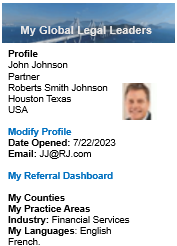
 Software
Software Law
Law Legal
Legal
